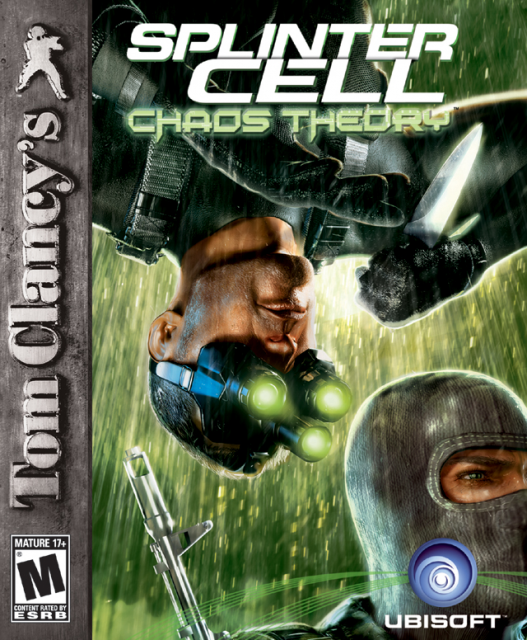No need to theorize - Sam can provide all the chaos you need.
Along with Rainbow Six and Ghost Recon, Splinter Cell brings to the world of gaming all the international intriguing cloak and dagger of espionage. Splinter Cell: Chaos Theory is the third game in the long running Tom Clancy series developed by Ubisoft Montreal.
This time, Sam Fisher, a 'Splinter Cell' agent from a secret U.S government office called Third Echelon, and the game's protagonist, has to stop a terrorist group from seizing and using a computerized weapon system on the innocent. While not being the most creative story, it does provide some interesting situations in locations spread all around the world, like Tokyo and Seoul.
All the tools and gadgets from past games are present in Chaos Theory, including the various visors Sam can use to track different elements in the environment, and attachments that can be used on the rifle that is carried, in order to pacify enemy patrols in a quiet and non lethal fashion. One new addition is the combat knife which provides quick and silent kills, with a touch of a controller trigger. Speaking of triggers, the choice between killing someone rests on them. By pressing the left trigger while holding an enemy, he's taken down in a non lethal manner, while pressing the right trigger provides a more aggressive - and violent - solution. Choosing between these plays a part in missions where there are civilians around, since one direct innocent death equals a failure. Other than these cases, killing or incapacitating a victim doesn't effect your overall result. At the beginning of every mission, an assortment of weapons and items is sorted in three classes - stealth, assault and a recommended package. Usually, the choice doesn't effect the overall progression of the level, since most items can be found scattered in store rooms, conveniently enough.
Sneaking is still a major part of the game, and sticking to dark areas, moving quietly and not alerting enemies is the way to go in most cases. Lights can generally be shot out - or blown out in case of candles in a certain mission - while cameras have to be avoided and are invulnerable to weapon fire. Some of these cameras can also possess infra red vision, which can track Sam in the dark. Along with these surveillance always present in any respectable stealth action game, UAVs also make their presence in a mission. These flying robots can not only track targets in the dark, but also shoot back, providing an extra challenge to the game. There is, however, still a presence of trial and error in many locations, due to some erratic enemy behavior, both mechanical and human.
A darker tone is present in Chaos Theory, which provides a Mature rating not present in past games of the series. There are, however, many humorous moments provided by the various characters present in the levels. Enemy troops, no matter their nationality, always speak English, with strong and over the top accents. Interrogation will normally net Sam with info regarding their mission, but from time to time, a joke will be thrown, making many cultural references. Jabs at another certain stealth action game happen often, in dialogues between Sam, played again by Michael Ironside - of Total Recall fame - and Lambert, Sam's contact in Third Echelon, voiced by Don Jordan. The orchestrated soundtrack sometimes seems over the top as well, and very limited, with the same track being played at various points in the game. Normally, though, silence will be Sam's only companion, with confrontations and tense moments being the cue for a dramatic score - or a bizarre techno beat, in a case or two in some levels.
The graphical presentation of Chaos Theory is just as slick as ever, with great atmospheric lighting and texture work. Characters as mostly well rendered, although all enemies caught in Sam's grip tend to look similarly, and behave the same way when scared, independent of race or ethnical differences. Fisher moves smoothly, with excellent transition animations between rolls and dodges. Still, rotating him to another direction looks out of place, since he'll just slide in a set pivot point, which detracts from the overall realism the game tries to set. Surfaces on walls and on the ground also tend to reflect light realistically, but will behave strangely in terms of providing dark hiding spots, with bright spots in the reflections being considered unlit by the game.
A play through of the game will take around ten hours from start to end, with the possibility of replays at the game's three different difficulty settings. These settings tweak the sense of awareness of guards, as well as the quantity of available equipment, and the times alarms can be triggered in the missions. The challenge tends to be rather unbalanced at certain points, due to erratic programmed intelligence given to enemy units, and the complexity of the game's control scheme, which can be overwhelming to someone new to the Splinter Cell series. For this, the game tries to remedy the situation with some tutorial videos, which are sadly hidden away at a menu and not presented as a visible suggestion for new players to check out.
Splinter Cell: Chaos Theory, while not bringing anything particularly new to the series, still manages to provide interesting situations, enough to warrant a sneak and peek at what Mr. Clancy manages to come up with in this ever growing game series.
